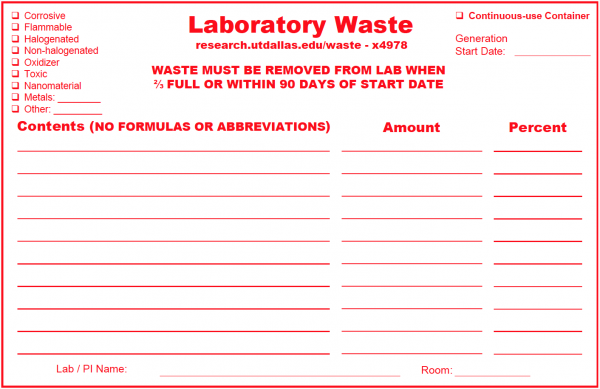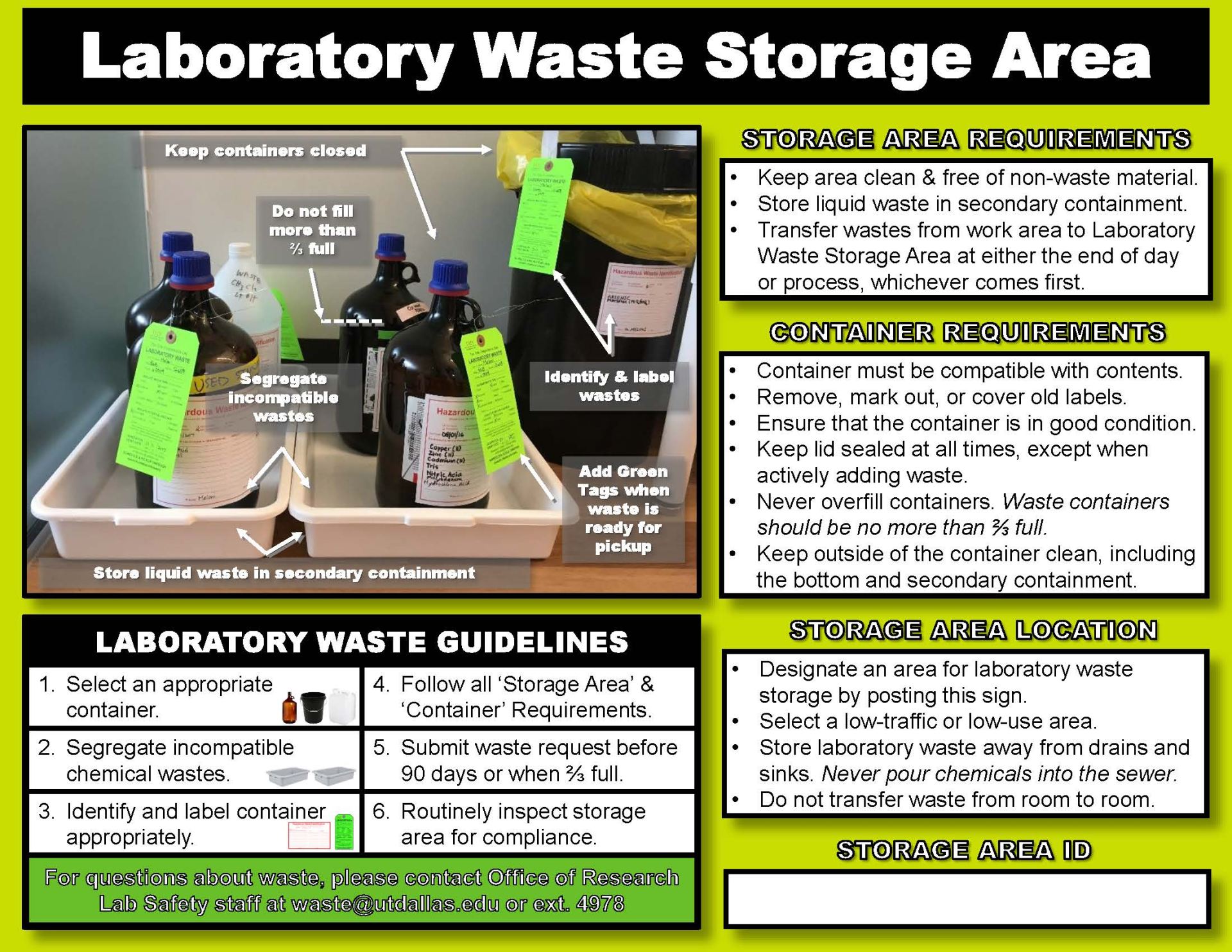Hazardous Waste
Hazardous waste is regulated and enforced at the Federal, State, and local levels. UT Dallas policies are in place to aid in compliance with these regulations. Environmental Management is responsible for the development and implementation of proper management practices for all aspects of the handling, storage, and disposal of hazardous wastes generated on campus.
Each University employee, student, and volunteer must comply with the campus hazardous waste management policies and all applicable regulations. Every individual is responsible for labeling and identifying their waste, proper storage of waste in their area, and requesting timely waste removal. All chemical wastes should be managed as if they are hazardous wastes.
Laboratories: An overview of basic storage and labeling requirements, disposal procedures, and common concerns for each waste type, can be found in the Laboratory Waste Disposal Guide.
Hazardous Waste Regulations and Policy
The Environmental Protection Agency (EPA) publishes the federal regulations under the Resource Conservation and Recovery Act (RCRA). This establishes a framework to identify hazardous waste. The EPA also gives guidelines and minimum requirements for managing hazardous waste for waste generators, transporters, and treatment, storage, and disposal facilities (TSDFs). In Texas, the Texas Commission on Environmental Quality (TCEQ) publishes state regulations to institute additional, stricter requirements. Local government, like the City of Richardson, can further regulate and enforce areas of environmental regulation. Other agencies which also govern some aspects of hazardous waste management include the Texas Department of State and Health Services (DSHS), the U.S. Department of Transportation (DOT), and the Occupational Safety and Health Administration (OSHA).
The primary goals of the hazardous waste regulations are:
- To protect human health and the environment from the potential hazards of waste disposal,
- To conserve energy and natural resources,
- To reduce the amount of waste generated, and
- To ensure that wastes are managed in an environmentally sound manner.
Waste Minimization / Pollution Prevention
The University is required to develop and implement waste minimization strategies. Ways to reduce the amount of chemical waste include, but are not limited to, the following:
- Practice the concept of Source Reduction by simply ordering the smallest quantity of materials required for your research.
- Substitute hazardous chemicals with non-hazardous chemicals whenever possible.
- Keep an inventory of chemicals in your lab by using ChemTracker.
- Share surplus chemicals with other labs.
- Purchase mercury-free instruments.
- Reduce the scale of laboratory experiments to reduce the volume of waste being produced whenever possible.
For additional ideas or support please contact waste@utdallas.edu.
Training
All personnel who generate, handle, manage, or dispose of chemical laboratory waste must complete the “Managing Hazardous Waste: Chemical Waste” training prior to working in a lab.
All training courses are assigned and accessible through the laboratory management system, BioRAFT. A NetID and registration with a UT Dallas research laboratory is required for access. If you are visiting a campus lab or do not have a NetID, please contact Safety@utdallas.edu for a temporary account.
Waste Disposal
Wastes Acceptable for Standard Pick-Up
- Liquid waste in suitable containers that are clean, free of contamination, and have a leakproof cap;
- Dry and/or solid waste in a suitable container that is clean, free of contamination, and properly tied or sealed;
- Chemically contaminated sharps (with no infectious or biohazardous contamination) in a rigid sharps container; and
- Treated infectious waste streams or deactivated biological agents that are mixed with chemical wastes.
Note: Biohazardous wastes are still acceptable for pick-up through the waste request forms, however, they must be noted as such and not combined with chemical waste, unless treated.
Wastes Unacceptable for Standard Pick-Up
- Radioactive Waste;
- Controlled Substances;
- Reactive waste streams without a properly vented cap, or containers that are bulging, fuming, or bubbling;
- Leaking, overflowing, or contaminated containers, or containers that are compromised;
- Wastes that require special handling procedures or have shipping restrictions; and
- Waste streams in incompatible containers.
For these types of wastes, please contact waste@utdallas.edu to arrange for pick-up.
Laboratory Waste Management
Training
All personnel who generate, handle, manage, or dispose of chemical laboratory waste must complete the “Managing Hazardous Waste: Chemical Waste” training prior to working in a lab.
All training courses are assigned and accessible through the laboratory management system, BioRAFT. A NetID and registration with a UT Dallas research laboratory is required for access. If you are visiting a campus lab or do not have a NetID, please contact Safety@utdallas.edu for a temporary account.
Hazardous Waste Identification
UT Dallas adheres to Subpart K of the federal hazardous waste management regulations, which are specific to university laboratories.
Under this subpart of the regulations, lab personnel are not required to determine if chemical wastes are hazardous per regulations; however, they must still be aware of the classification procedures. This will ensure that sufficient information is provided to hazardous waste personnel, so that they can perform the waste classification and know the proper storage and disposal requirements. All laboratory wastes should be managed as if they are hazardous waste. Chemical waste generated in the laboratory should be referred to as “Laboratory Waste,” rather than “Hazardous Waste” since the final waste determination will be made outside the lab.
Hazardous Waste Classification
Waste Classification training is presented to provide a general understanding of the federal and state regulations that apply to the disposal of hazardous waste. Research and Academic Safety assumes responsibility for removing all waste chemicals from your laboratory, making the final hazardous waste determination, and determining appropriate storage and disposal methods.
Simply defined, a hazardous waste is a waste with properties that make it dangerous or capable of having a harmful effect on human health or the environment.
As defined under RCRA, it is specifically waste that exhibits the characteristics of hazardous waste including ignitability, corrosivity, reactivity, and toxicity. In addition, chemicals included on the F, K, P, and U Lists are considered hazardous. Wastes only have to be identified by one characteristic, or be listed, to be considered an RCRA hazardous waste.
P-listed chemical waste has additional, more stringent waste requirements. These wastes only include discarded commercial chemical products, off-specification species, container residues, and spill residues. For additional information, including a list of P-listed chemicals, visit the P-Listed Waste information page.
Labeling of Waste Containers
All the chemical constituents in each waste stream must be accurately identified by knowledgeable laboratory personnel. This is a critical safety issue for both laboratory employees and the waste personnel that handle the waste once it is turned over to the Research and Academic Safety Team. Mixing of incompatible waste streams has the potential to create violent reactions and is a common cause of laboratory accidents. If there is uncertainty about the composition of a waste stream resulting from an experimental process, laboratory workers must consult the PI/Laboratory Supervisor or Safety Specialist. In most cases, careful documentation and review of all chemical products used in the experimental protocol will result in accurate waste stream characterization.
Waste constituents should be listed on the red-and-white Laboratory Waste Label affixed to each waste container as soon as the waste is added to the container.

Labeling requirements and guidelines include the following:
- Fill-in the “Generation Start Date” field as soon as waste is added to the container;
- Inspect waste containers to ensure that containers have legible labels, are compatible with the generated waste stream, and have secure closures;
- Clearly spell out the name of each chemical component on the label. Do not use molecular formulas as sole identification;
- Any incorrect labels should be defaced/marked through and replaced with accurate labels.
This label is in addition to the “Laboratory Waste” tag, which is required when the container is ready for pickup.
See the attached Laboratory Waste Information Sheet on “Laboratory Waste Labels and Tags.”
Waste Container Storage
Sample Label of a Laboratory Waste Storage Area

Laboratory Waste Guidelines
- Select an appropriate container.
- Segregate incompatible chemical wastes.
- Identify and label containers appropriately.
- Follow all ‘Storage Area’ and ‘Container’ Requirements.
- Submit waste request before 90 days or when 2/3 full.
- Routinely inspect storage area for compliance.
Storage Area Requirements
- Keep area clean & free of non-waste material.
- Store liquid waste in secondary containment.
- Transfer wastes from work area to Laboratory Waste Storage Area at either the end of day or process, whichever comes first.
Container Requirements
- Container must be compatible with contents.
- Remove, mark out, or cover old labels.
- Ensure that the container is in good condition.
- Keep lid sealed at all times, except when actively adding waste.
- Never overfill containers. Waste containers should be no more than 2/3 full.
- Keep outside the container clean, including the bottom and secondary containment.
Storage Area Location
- Designate an area for laboratory waste storage by posting this sign.
- Select a low-traffic or low-use area.
- Store laboratory waste away from drains and sinks. Never pour chemicals into the sewer.
- Do not transfer waste from room to room.
For questions about waste, please contact Office of Research Lab Safety Staff at waste@utdallas.edu or ext. 4978.
Laboratory personnel must properly manage containers of unwanted material in the laboratory to assure safe storage of the unwanted material, to prevent leaks, spills, emissions to the air, adverse chemical reactions, and dangerous situations that may result in harm to human health or the environment. Proper storage area and container management includes the following:
- Keep area clean and free of non-waste material.
- Store liquid waste in secondary containment.
- Transfer wastes from work area to Laboratory Waste Storage Area at either the end of day or process, whichever comes first.
- Container must be compatible with contents.
- Remove, completely mark out, or cover old labels.
- Ensure that the container is in good condition.
- Keep lid sealed at all times, except when actively adding waste.
- Do not fill containers greater than ⅔ the volume.
- Keep outside of container clean, including the bottom.
See the attached Laboratory Waste Information Sheet (pdf) on “Where does my waste go?” and “Basic Waste Reminders.”